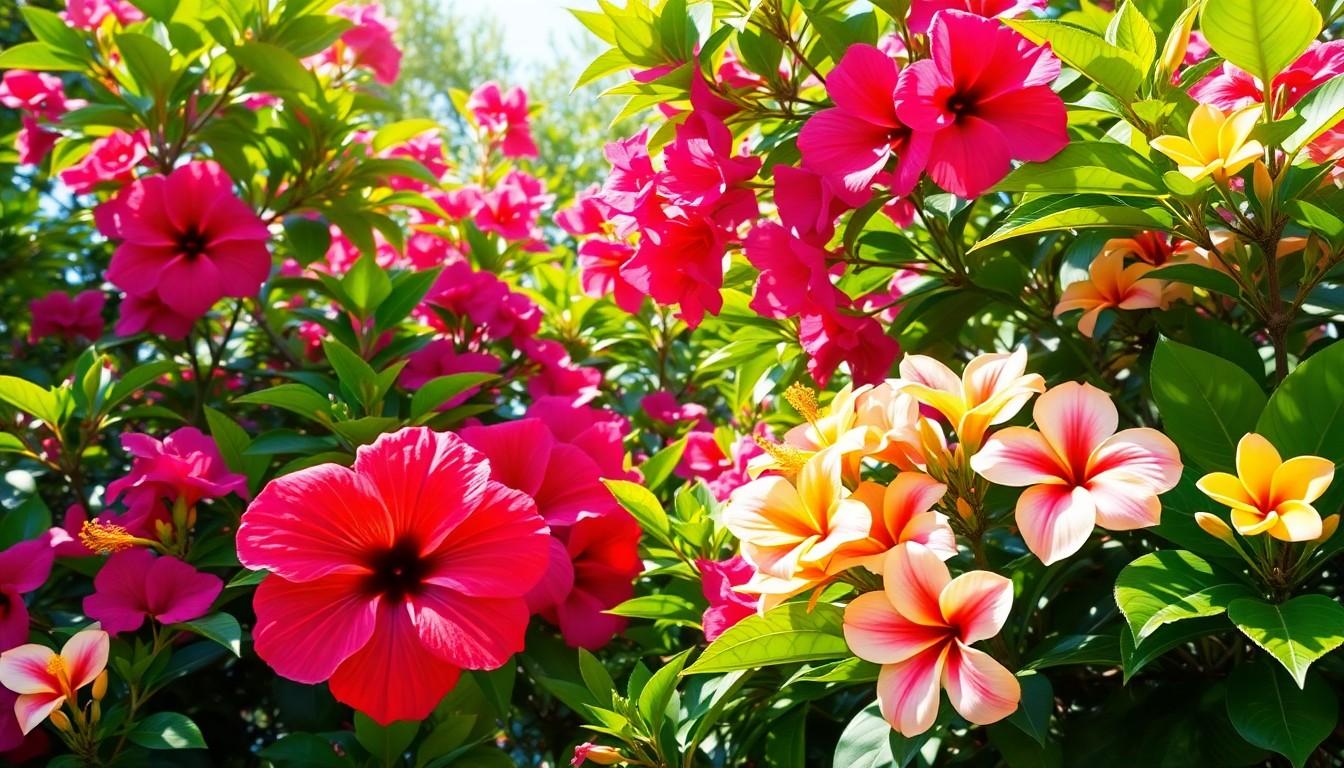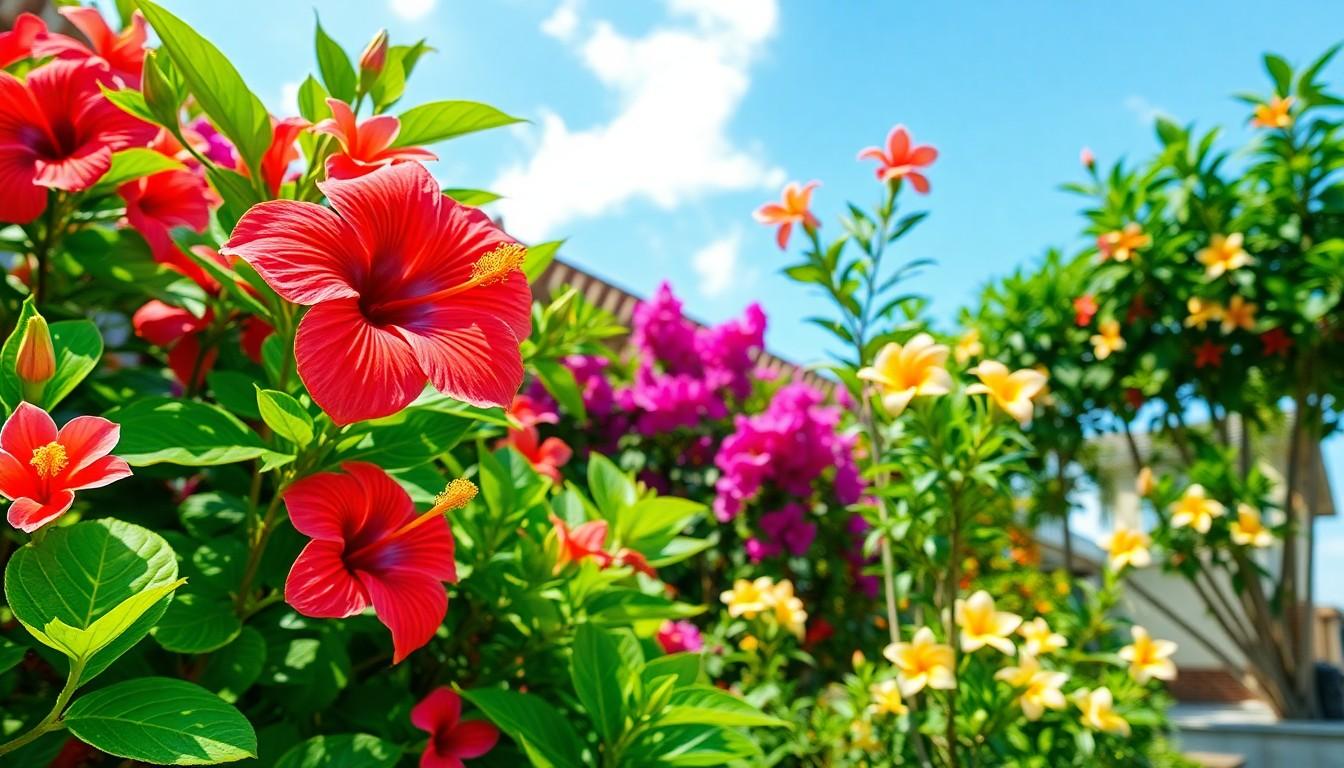Physical Address
304 North Cardinal St.
Dorchester Center, MA 02124

Imagine stepping into a vibrant paradise where colors explode and fragrances dance in the air. Outdoor tropical flowering plants can transform any garden into a lush oasis, turning even the most ordinary backyard into a slice of heaven. With their stunning blooms and irresistible charm, these plants not only brighten up spaces but also bring a touch of the tropics right to your doorstep.
Outdoor tropical flowering plants enhance gardens with their vivid colors and captivating scents. These plants thrive in warm, humid climates, making them ideal for regions that experience such conditions. Species like hibiscus, bougainvillea, and plumeria stand out due to their eye-catching blossoms.
Hibiscus features large, trumpet-shaped flowers that bloom in various colors, attracting pollinators like bees and butterflies. Bougainvillea showcases vibrant bracts, providing a stunning backdrop in any landscape. Plumeria, known for its fragrant blooms, often appears in tropical lei arrangements.
Diversity in this plant group offers gardeners many options. They can choose from plants that bloom year-round or those that have specific blooming seasons. Foliage also varies significantly, from broad-leaved varieties to more delicate leaf structures, enabling unique landscape designs.
Care methods differ among species. Most outdoor tropical flowering plants prefer well-drained soil rich in organic matter. Regular watering is crucial, especially during dry spells, while proper fertilization supports healthy growth and flower production.
Understanding local climate conditions aids in selecting the right species. Tropical plants require consistent warmth, which may necessitate protective measures in cooler months. Proper plant placement ensures they receive adequate sunlight while preventing them from overcrowding.
Selecting outdoor tropical flowering plants enhances not only aesthetic appeal but also promotes biodiversity. These plants invite pollinators and provide habitats for various wildlife, contributing to a healthier ecosystem. Through thoughtful planting, one can create a vibrant paradise in any outdoor space.

Outdoor tropical flowering plants bring vibrant beauty to gardens. Various species thrive in warm climates, each offering unique characteristics.
Hibiscus captivates with its large, colorful trumpet-shaped flowers. These blooms attract pollinators like butterflies and hummingbirds. Gardeners appreciate the plant’s robust nature, which allows it to flourish in diverse soil types. Regular pruning enhances its shape and promotes more blooms. American hibiscus cultivars, known for their striking colors, stand out in many landscapes. Species include the hardy hibiscus and tropical hibiscus, each displaying distinct flower sizes and colors. An ideal location will provide full sun and well-drained soil, optimizing growth and flower production.
Bougainvillea dazzles with its vibrant bracts that cover the plant in brilliant hues. Available in shades of magenta, orange, and white, these plants create stunning backdrops in gardens. This drought-resistant plant requires minimal care, making it suitable for busy gardeners. Training bougainvillea on trellises or walls enhances its visual appeal, creating an eye-catching focal point. Regular watering promotes healthy growth, while too much water can lead to root rot. Choose a sunny spot with good drainage to ensure optimal blooming throughout the year.
Plumeria, also known as frangipani, is prized for its fragrant flowers that evoke tropical tranquility. Blossoms come in various colors, including white, yellow, and pink, often used in traditional lei arrangements. Planting plumeria in well-drained soil encourages optimal growth and flowering. Its growth habit ranges from shrub to small tree, offering versatility in landscaping. Pruning promotes a bushier appearance and improves air circulation around the plant. Adequate sunlight and regular watering contribute to its health and spectacular flowering displays.
Outdoor tropical flowering plants thrive under specific growing conditions that ensure their vibrant blooms and overall health. Understanding these needs is essential for effective gardening.
Full sunlight is crucial for many tropical flowering plants. Hibiscus prospers in direct sunlight, requiring at least six hours daily to maximize its colorful blooms. Bougainvillea flourishes in bright sunlight, making it perfect for sunny gardens. Plumeria also enjoys full sun, which enhances the fragrance of its flowers. Gardeners should ensure these plants receive adequate light, as insufficient sunlight can lead to weak growth and fewer flowers.
Well-drained soil significantly benefits outdoor tropical flowering plants. Hibiscus thrives in slightly acidic to neutral soil, with good drainage to prevent root rot. Bougainvillea prefers sandy or loamy soil that allows excess water to escape easily. Plumeria flourishes in a mix that combines potting soil with perlite or sand, promoting drainage while retaining some moisture. Careful selection of soil type contributes to healthy root systems and vibrant flowering.
Regular watering supports the growth of tropical flowering plants. It’s important to water hibiscus deeply but infrequently, allowing the top layer of soil to dry out between sessions. Bougainvillea is more drought-tolerant and only requires water during prolonged dry spells. Plumeria needs consistent moisture during the growing season, but overwatering should be avoided. Adapting watering techniques based on seasonal changes improves plant vitality.
Caring for outdoor tropical flowering plants ensures they remain vibrant and healthy. Attention to specific tasks can greatly enhance their growth and blooming potential.
Pruning tropical flowering plants supports healthy growth and abundant blooms. Start with hibiscus, which benefits from trimming after flowering to encourage bushiness. Bougainvillea requires occasional cutting back to manage its size and remove dead stems. Plumeria thrives with light pruning to shape and promote airflow, preventing disease. Regularly inspect plants for dead or damaged branches, and remove them to maintain overall vitality. Timing plays a crucial role; late winter or early spring is an ideal period for most species, allowing them to recover before the growing season begins.
Fertilizing outdoor tropical flowering plants provides essential nutrients for optimal health. Opt for a balanced fertilizer once a month during the growing season for hibiscus and plumeria, promoting lush foliage and vibrant flowers. Bougainvillea requires a phosphorus-rich fertilizer to encourage bright bracts; use it sparingly, as too much can inhibit flowering. Watering the plants after fertilization ensures the nutrients reach the root zone. Observe the specific needs of each plant, adjusting the schedule based on growth patterns and environmental conditions. Regularly testing soil can also help pinpoint any nutrient deficiencies, allowing for targeted intervention.
Outdoor tropical flowering plants provide numerous advantages for gardens and landscapes. Vibrant colors and attractive blooms enhance aesthetic appeal, transforming spaces into visual masterpieces. Each species brings unique characteristics that elevate the environment.
The ability to attract pollinators such as bees and butterflies fosters a thriving ecosystem. Healthy pollinator populations benefit gardens and support biodiversity. Fragrant flowers from plants like plumeria create inviting outdoor areas, enhancing sensory experiences.
Tropical flowering plants can improve air quality as they undergo photosynthesis. Increased greenery within spaces contributes to cleaner air and reduces pollutants. These plants’ natural habitats often support wildlife, offering shelter and food sources.
Additionally, outdoor tropical flowering plants play a role in temperature regulation. They provide shade, lowering ground temperatures during hot summer months. This creates more comfortable outdoor spaces for leisure and gatherings, which encourages prolonged outdoor activities.
With proper care, many tropical flowering plants are relatively low maintenance. Species like bougainvillea thrive with minimal watering, allowing gardeners to enjoy beautiful blooms without excessive effort. Moreover, their resilience in warm, humid climates means they adapt well to various growing conditions.
Lastly, these plants contribute to mental well-being by creating serene, vibrant landscapes. Engaging with nature reduces stress and promotes relaxation, making gardens a perfect retreat. Outdoor tropical flowering plants, therefore, not only beautify spaces but also enhance overall quality of life.
Outdoor tropical flowering plants are a remarkable addition to any garden. Their vibrant colors and delightful fragrances create an inviting atmosphere that elevates outdoor spaces. By selecting the right plants and providing proper care, gardeners can enjoy a lush paradise year-round.
These plants not only enhance aesthetic appeal but also support local ecosystems by attracting pollinators and improving air quality. Embracing tropical flowering plants transforms ordinary gardens into vibrant retreats that foster relaxation and well-being. With the right choices, anyone can cultivate a thriving outdoor oasis that brings joy and beauty to their surroundings.